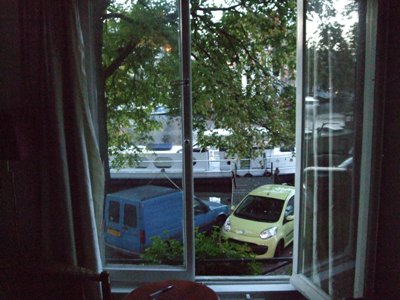 We stayed at The Amsterdam House, a pleasant hostelry overlooking the Amstel river in between the Mund tower and the Stopera. Breakfasts were good and the whole place characterful with its narrow staircases and low ceilinged rooms.
We stayed at The Amsterdam House, a pleasant hostelry overlooking the Amstel river in between the Mund tower and the Stopera. Breakfasts were good and the whole place characterful with its narrow staircases and low ceilinged rooms.
Roland and I have just made one of our trips abroad together. The excuse was the opera performance mentioned below.
We went to Amsterdam which we also visited together in October of 2004. Six years ago, I was recovering from a period of clinical depression and I was still on medication. This visit gave me an idea of how far that I have come in that time. I certainly felt much more present and had more energy and confidence to be on my own.
In other respects, I am still as much a prisoner of my own psychology as ever. Despite any external evidence, I am not the self-confident individual which I appear and I shrink from contact with my fellows.
Anyhow, the holiday. We travelled over to Amsterdam by KLM. It was only a few more pounds than Easyjet and the times were more convenient and the service was qualitatively better.
 We stayed at The Amsterdam House, a pleasant hostelry overlooking the Amstel river in between the Mund tower and the Stopera. Breakfasts were good and the whole place characterful with its narrow staircases and low ceilinged rooms.
We stayed at The Amsterdam House, a pleasant hostelry overlooking the Amstel river in between the Mund tower and the Stopera. Breakfasts were good and the whole place characterful with its narrow staircases and low ceilinged rooms.
For October, it was really very mild and Roland and I had the windows of our room open a lot of the time.
 Using Roland's Dorling Kindersley book, we walked a great deal and visited a number of interesting places. I particularly liked Ons'Lieve Heer op Solder (Our Lady in the Attic), a Catholic church hidden inside a house.
Using Roland's Dorling Kindersley book, we walked a great deal and visited a number of interesting places. I particularly liked Ons'Lieve Heer op Solder (Our Lady in the Attic), a Catholic church hidden inside a house.
![]()
How hidden it could have been, I am not so sure. There was room for a congregation of up to one hundred. That level of regular visiting on a Sunday must surely have taken some explaining.
The place was being renovated and so much of the church was in pieces. Nevertheless, it was a place with a sense of presence. I particularly liked the Delph tiles in the kitchen area.
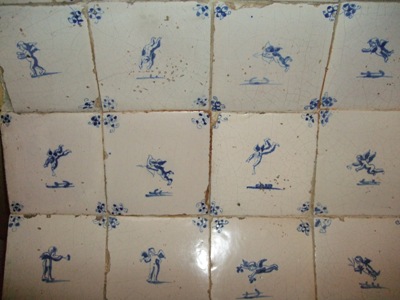
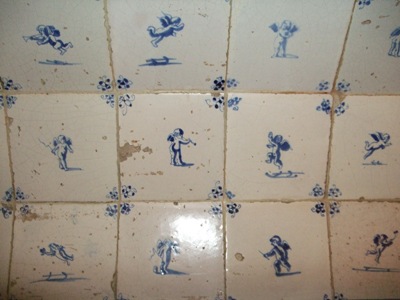
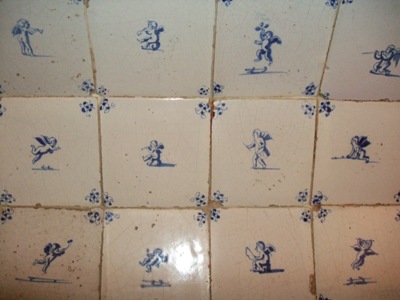
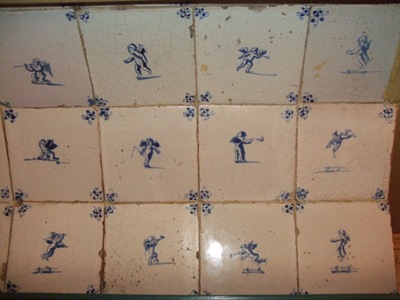
I now know how widely these are liked. However, on a first meeting, I did not know this. It was the naïveté of the designs which I liked best along with the fact that no two were alike.
We also walked a lot by the canal sides. The first morning that we were there, I rose early and, by early opalescent like, walked through a damp, mist-enshrouded world where the canals were thronged with sleeping wild foul, storks and swans.
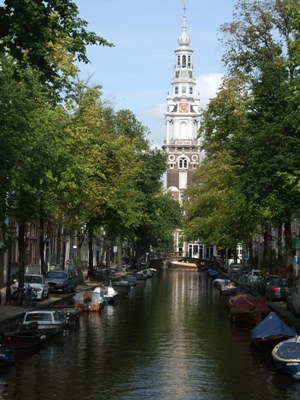
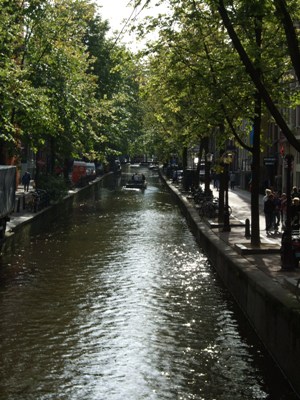
We ate well - a couple of times at the Chinese restaurant we frequented on our last visit, Sluizer which we had also visited and a few other eateries as well. We drank beer but not too much.
 We also did art. The Rijksmueum is still mostly closed for restoration. We took in the highlights exhibition and so I have now seen Rembrandt's The Night Watch which has the same iconic status in the Netherlands as certain Constable's and Turner's do in the UK.
We also did art. The Rijksmueum is still mostly closed for restoration. We took in the highlights exhibition and so I have now seen Rembrandt's The Night Watch which has the same iconic status in the Netherlands as certain Constable's and Turner's do in the UK.
Mostly, though, I didn't like the collection (it was just too Dutch, my dears). The one major exception was this work, The Little Street by Vermeer, which felt as fresh as if it had just been painted.
![]()
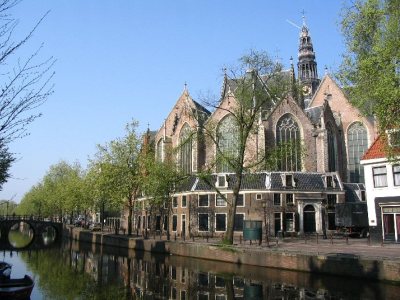 We also took in a pleasant organ recital at the Oude Kerk which, though you wouldn't know it from this photograph is right in the middle of the Red Light District.
We also took in a pleasant organ recital at the Oude Kerk which, though you wouldn't know it from this photograph is right in the middle of the Red Light District.
The only fun aspect of this area was the behaviour of the young men which must hardly have changed in four hundred years. Roaming in packs, they couldn't make up their minds what to do as a group. Each group seemed to be waiting on one courageous individual to decide on the course of the evening's entertainment.
A couple of times, I witnessed a small knot of youths affecting an air of boredom and patience whilst waiting whilst one of their companions spent time in one of the cabins.
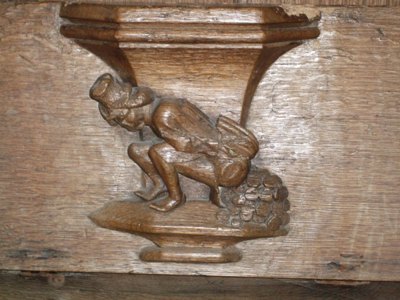 The church itself is out of commission and is under a process of continual restoration.
The church itself is out of commission and is under a process of continual restoration.
I did like the choir stalls with their carved misericords dating from the late fifteenth century. Like so much of that time, there is a healthy blend of the spiritual and the earthy.
This carving represents the Dutch proverb "Money doesn’t fall out of my arse" which is our equivalent of "Money doesn’t grow on trees".
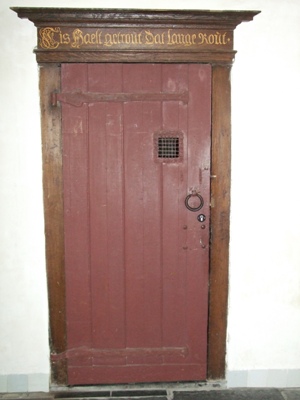 The door of the sacristy of the Old Church is red. It is the entrance to the marriage registry and so, when people in Amsterdam spoke of "going through the red door", they meant that they were going to take out a marriage license. Above the door is written "Marry in haste, repent at leisure". I don't know if this is the original source of this saying or if it is simply its most prominent record.
The door of the sacristy of the Old Church is red. It is the entrance to the marriage registry and so, when people in Amsterdam spoke of "going through the red door", they meant that they were going to take out a marriage license. Above the door is written "Marry in haste, repent at leisure". I don't know if this is the original source of this saying or if it is simply its most prominent record.
![]()
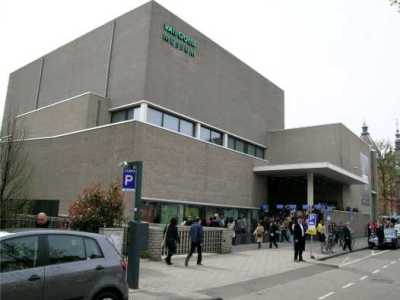 Probably the highlight of the visit for me was my visit to the Van Gogh Museum. It was truly exciting to see so many works by this great artist in one place at the same time.
Probably the highlight of the visit for me was my visit to the Van Gogh Museum. It was truly exciting to see so many works by this great artist in one place at the same time.
![]()
And what came home to me was just how short his active life as an artist was. The Potato Eaters is one of his earliest acknowledged masterworks. This was completed in 1885. Wheatfield with Crows was completed in July 1890. On 27 July of that year, van Gogh shot himself in the chest with a pistol and died two days later.

Even that five years was regularly interrupted by periods of ill health both physical and mental. There was the disastrous period in Arles when he attempted to set up an artists colony along with Gaugin and Bernard. But this difficult time also saw the creation of paintings of orchards in blossom and fields being harvested.


I could have stayed longer but the opera called.
Some time ago, I listed the following operas as those I would like to attend.
As you can see, this Journal is a record of the way that the list has been ticked off. The final opera on the list was Verdi's Les vêpres siciliennes and it was this which De Nederlandse Opera had on offer. Given the precarious nature of the future of the British economy, my future employment and my future finances, some would say that this trip was foolhardy. But it has fulfilled a dream and so I am counting it all as money well spent.
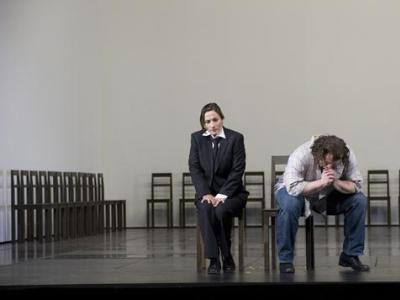 However, although I have attended a musical performance of Verdi's work, I cannot in truth say that I have seen a performance of the piece. Christof Loy is a fine and an intelligent theatrical director. But he gave us his story and his plot and his version of French history.
However, although I have attended a musical performance of Verdi's work, I cannot in truth say that I have seen a performance of the piece. Christof Loy is a fine and an intelligent theatrical director. But he gave us his story and his plot and his version of French history.
Anyhow, I now know why Les vêpres siciliennes is so rarely performed. For a piece which was composed just after La Traviata and before Simon Boccanegra and Un ballo in maschera, you would have thought that it would have retained a regular toe hold in the repertoire. But no, the music is reasonable without being memorable; there is only one great memorable tune and that is the bolero. And the plot is tortuous even by mid-nineteenth century standards.
So for the music. Well, Paolo Carignani conducted the Netherlands Philharmonic Orchestra with reasonable panache and the principals (Barbara Haveman as Hélène, Alejandro Marco-Buhrmester as Montfort, Burkhard Fritz as Henri and Balint Szabo as Procida) all conducted themselves with some dignity. I just wasn't gripped in the way that I normally am by Verdi.
Would I now go and see another performance? Well, on this basis, I would avoid the piece. But I wouldn't travel to the ends of the earth to sample it again.
![]()
Back to the hotel, pick up bags, off to the airport, a final glass of beer and then the flight home. When it works, the transport system is a thing of great and intricate beauty.
 During my travels, I read A Week in December by Sebastian Faulks. It was a good read and an apt portrait of aspects if contemporary London. However, I think that Ian McEwan does it all so much better and I really didn't like the view of the current education system which the author kept giving to his characters.
During my travels, I read A Week in December by Sebastian Faulks. It was a good read and an apt portrait of aspects if contemporary London. However, I think that Ian McEwan does it all so much better and I really didn't like the view of the current education system which the author kept giving to his characters.
![]()